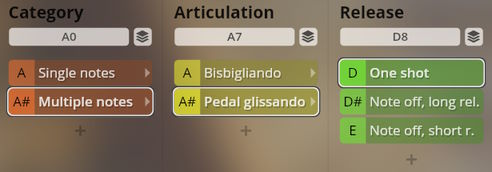SYNCHRON-ized Harps
Introduction
Welcome to the Vienna Symphonic Library’s series of Synchron Instruments! SYNCHRON-ized Harps is based on its Vienna Instruments namesake, and offers a completely overhauled sample database optimized for the Vienna Synchron Player. Our goal was to improve these ensemble’s playability and realism even more, which we achieved by enhancing the sample recordings as well as by utilizing the Synchron Player’s unique features.
About Preset
The harp, a stringed and plucked instrument, is one of the oldest and most widespread musical instruments known to man.
In modern orchestral and concert playing the double-action pedal harp has established itself, a model with 7 pedals and 47 strings tuned diatonically in Cb major. (The tuning is not called B major for reasons of convenience. By depressing all the pedals to the first or second notch, the tuning can be raised to C natural and C sharp.)
The harp has a range from Cb1–G#7.
As with the piano, harp notation is written on two staves and is non-transposing. The lower staff is in bass clef, the upper in treble clef. If required by the register both staves can be in the same clef, either bass or treble.
About Patches
Patches can be used to build your own custom Presets and adapt the Synchron Libraries to your specific requirements. For further information on constructing Presets, please see the Synchron Player manual.
Mixer Presets
For each instrument, there are a number of Mixer Presets that depict different recording situations. The basic Mixer Presets are Close, Classic, Distant, short and long Reverb without convolution, and MIR unprocessed; others (e.g., different positioning in the hall) may be added according to voice.
About Pitch
For designating pitch, the Vienna Symphonic Library uses International Pitch Notation (IPN), which was agreed upon internationally under the auspices of the Acoustical Society of America. In this system the international standard of A=440 Hz is called A4 and middle C is C4. All pitches are written as capital letters, their respective octave being indicated by a number next to it. The lowest C on the piano is C1 (the A below that is A0), etc.
The Synchron Player software allows you to set middle C to C3, C4, or C5 according to your preference. Selecting another setting than C4 will of course also change the play ranges and keyswitches accordingly.
Sound characteristics
Gentle, metallic, blurring, resonant, short, hard, drifting, full-sounding, rushing, clear, brilliant, glittering, flowing, dull, mellow, sharp, crystal clear, reverberating, splashing, cascading.
The full-sounding notes of the lower register resonate for a long time.
A brilliant and warm timbre is characteristic of the middle register. Notes resonate for one or two seconds. It is chiefly in this register that chords, harmony, arpeggios, glissandos and melody lines are played.
The high register has bright, hard and penetrating notes that die away very quickly.
Combination with other instruments
The harp combines well with all orchestra groups.
It has the function of fleshing out the sound and is often treated as a filling-in instrument. The bottom strings are often used to play the bass voice. The weaving of delicate harmonic sound backdrops (arpeggio technique) is another of its quintessential tasks. In addition, it is the various types of harp glissando that lend the undulations of the orchestra the shimmer of brilliance which is one of the most fundamental sound experiences of them all.
The harp achieves a good blend with the strings because they are related to each other as stringed instruments. With the woodwind, chords in unison with the harp are one of the key combinations.
Included Presets
Synchron libraries generally offer different Presets according to how velocity is handled, arranged in separate folders.
“VelXF sus”: velocity crossfading is only activated for bisbigliando and glissandos, while the dynamics of all other patches are controlled by keystroke velocity, thus facilitating phrasing.
“VelXF”: all articulations have velocity crossfading activated so that you can control dynamics with MIDI controller CC1, the modwheel.
“Velocity”: note volume is controlled by keystroke velocity just like a piano.
Apart from that, velocity crossfading can always be enabled or disabled by clicking its on/off symbol in the Synchron Player's Perform tab.
Presets are subdivided into single and multiple note categories; within these, you can select specific articulations, e.g., regular single notes, or Major glissandos. If you happen to be short of RAM, you can deactivate Articulations you do not need, and activate them again if necessary.
Switching between playing styles and articulations is generally done via dedicated keys on the keyboard and aptly called “keyswitches”. The single/multiple switches are A0/A#0, the harps’ keyswitches for articulations are mapped starting from A7. Other keyswitches, such as release, direction, or speed, depend on articulation.
Harp 1
The harp was played by Ruth Rojahn, harpist of the Hofer Symphoniker and internationally successful soloist. It offers single notes regular, près-de-la-table, and harmonics; bisbigliando; glissandos major and minor, dominant 7 and minor 7, diminished, whole tone, and pentatonic; and three and four note arpeggios major, minor, diminished and augmented.
Range: B0–G#7.
Single/multiple notes keyswitches: A0/A#0.
Single notes
Single notes regular, faded or muted after release, and as short notes; près-de-la-table; harmonics.
- Range
- B0–G#7
- harmonics E3–A6
- Articulation: A7–C8 (white keys only)
- Regular notes length: D8–E8

Multiple notes
Bisbigliando, glissandos, and chord arpeggios with three and four notes.
- Range
- B0–G#7
- harmonics E3–A6
- Articulation: A7–C8
- Regular notes length: D8–E8
Bisbigliando
Bisbigliando or 'whispering', a sound effect created by soft tremolo play on the harp; with long and short release.
- Range: A2–E7
- Long/short release: D8/E8
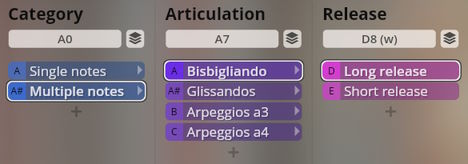
Glissando
Glissandos major and minor, dominant 7 and minor 7, diminished, whole tone, and pentatonic; up and down over 1, 3, and 5 octaves, as well as single and multiple cross glissandos. All at slow, medium, fast, and very fast speeds.
- Range: C3–E5 (white keys only; 1 octave: C3–D4; 3 octaves: F4–A4; 5 octaves: C5; single cross glissando: D5; multiple cross glissando: E5)
- Up/down: C7/C#7
- Speed slow to fast: F7–G#7
- Mapping: All glissandos are mapped to the C major scale
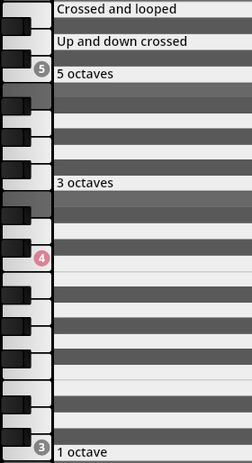
Major / minor
- Key change: A1–G#2
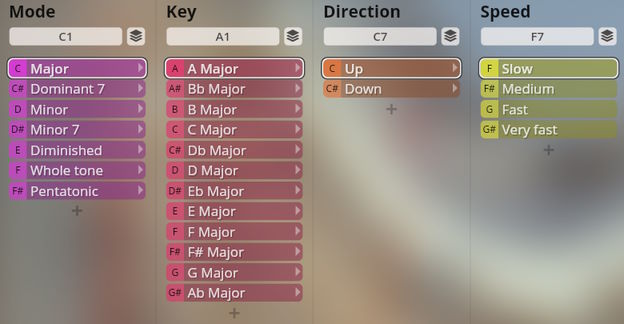
Dominant 7
- Key change: A1–C#2
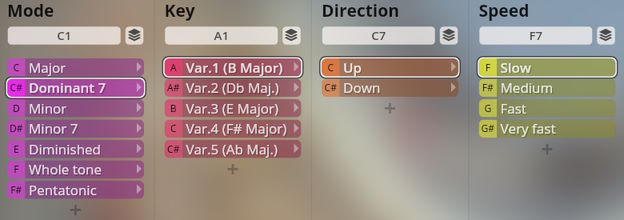

Minor 7
- Key change: A1–C#2


Diminished
- Key change: A1–B1
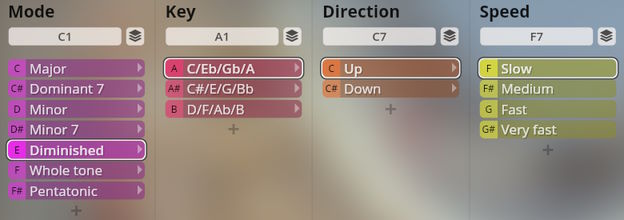

Whole Tone
- Key change: A1–A#1
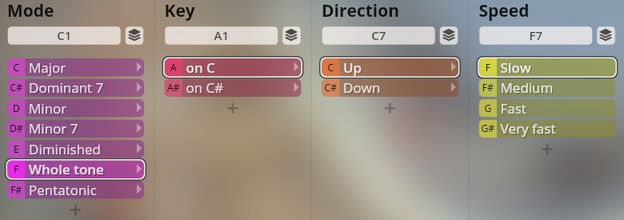
Pentatonic
- Key change: A1–C#2
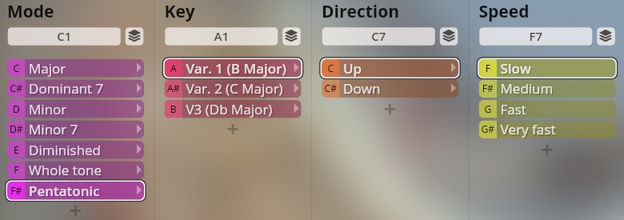

Arpeggios a3, Arpeggios a4
3- and 4-note arpeggios, major and minor, diminished and augmented upward arpeggios, slow, fast, and straight (played as chords).
- Slow/fast/chord: F7–G7
- Mapping:
- Major and minor arpeggios are mapped to the notes of their chords, and their play ranges vary accordingly. The mapping of 3-note arpeggios goes one note higher than that of the corresponding 4-note ones. (The last tone of the highest 4-note arpeggio on the same note would exceed the harp's play range.)
Major / minor
- Range: according to key
- Key change: A1–G#2
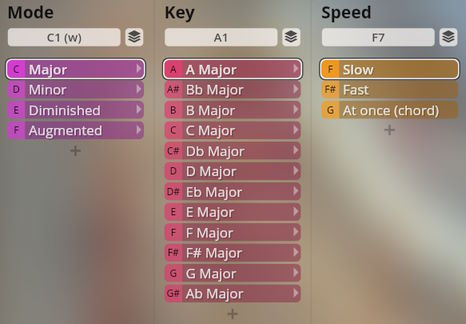
Diminished
- Range
- 3-note: C3–D7
- 4-note: C3–B6
- Slow/fast/chord: F7–G7
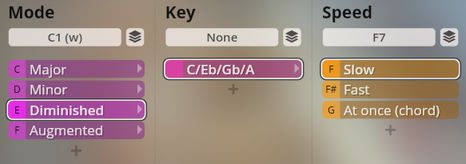
Augmented
- Range
- 3-note: H2–C7
- 4-note: H2–G#6
- Slow/fast/chord: F7–G7
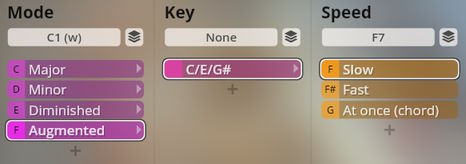
Harp 2
The second harp contains an even larger number of single notes that were additionally played with finger nails, damped, près de la table, as well as harmonics, bisbigliandos, and pedal glissandos. It was played by Julia Reth who shared the stage with orchestras such as the Vienna Philharmonic, Wiener Symphoniker, Radio Symphony Orchestra Vienna, Klangforum Wien, Neue Oper Wien, and many others.
- Range: B0–G#7
- Single/multiple notes keyswitch: A0/A#0
Single notes
Regular single notes faded and muted after release, short, and damped; près-de-la-table, fingernails, and harmonics.
- Range: B0–G7
- damped A#1–G6
- près-de-la-table A1–G7
- harmonics G3–C7
- Articulation: A7–C8
- Regular notes length: D8–F8
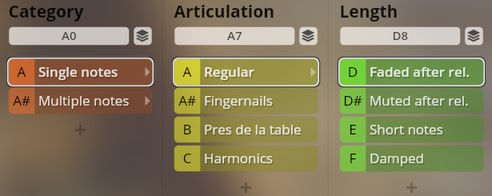
Multiple notes
Bisbigliando and pedal glissando.
- Articulation: A7/A#7
Bisbigliando
Bisbigliando with long and short release.
- Range: A1–G6
- Long/short release: D8/E8

Pedal glissando
Pedal glissando as one-shot, as well as with the glissando on note off, with long and short release.
- Range
- one shot C1–G7
- note off B0–G7
- Release: D8–E8
